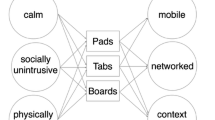Abstract
Designing transparent interaction is important for ubiquitous computing (ubicomp). A psychology framework that characterizes user’s cognitive behavior in ubicomp environments would be invaluable for guiding the interaction design to be optimally compatible with human capabilities and limitations. By analyzing the cognitive skill and attention selectivity, such a framework is proposed in this paper. Correspondingly, a context-sensitive multimodal architecture is presented on the level of technology. A case study, where the theory was implemented in a handheld hypermedia guide and deployed into the context of authentic use, is then discussed.
Preview
Unable to display preview. Download preview PDF.
Similar content being viewed by others
References
Weiser, M.: Computers for the 21st Century. Scientific American 265(3), 94–104 (1991)
Garlan, D., Siewiorek, D.P., Smailagic, A., Steenkiste, P.: Project Aura: Toward Distraction-free Pervasive Computing. IEEE Pervasive Computing 1(2), 22–31 (2002)
Abowd, G.D., Mynatt, E.D.: Distributed Cognition: Toward a New Foundation for Human-Computer Interaction Research. ACM Trans. on Computer-Human Interaction 7(2), 174–196 (2000)
Barnard, P.J., Teasdale, J.D.: Interacting Cognitive Subsystems: A Systemic Approach To Cognitive-Affective Interaction And Change. Cognition and Emotion 5, 1–39 (1991)
Norman, D.: The Invisible Computer. MIT Press, Cambridge, Mass (1999)
Anderson, J.R.: Automaticity and the ACT Theory. American Journal of Psychology 105, 165–180 (1992)
Eysenck, M.W.: Principles of Cognitive Psychology. Psychology Press, UK (1997)
Kahneman, D.: Attention and Effort. Prentice-Hall, New Jersey (1973)
Oviatt, S.L., Cohen, P., et al.: Designing the User Interface for Multimodal Speech and Pen-based Gesture Applications: State-of-the-Art Systems and future research directions. Journal of Human-Computer Interaction 15(4), 263–322 (2000)
Salber, D., Dey, A.K., Abowd, G.D.: Aiding the development of Context-Enabled Applications, In: Proc. Conf. Human Factors in Computing Systems, pp. 434–441 (1999)
Schmidt, A., Karlsruhe, U.: How to Build Smart Appliances. IEEE Personal Communications 8(4), 66–71 (2001)
Massaro, D.W., Stork, D.G.: Speech Recognition and Sensory Integration: A 240-year-old Theorem Helps Explain how People and Machines Can Integrate Auditory and Visual Information to Understand Speech. American Scientist 86(3), 236–245 (1998)
Author information
Authors and Affiliations
Editor information
Rights and permissions
Copyright information
© 2007 Springer-Verlag Berlin Heidelberg
About this paper
Cite this paper
Yue, W., Wang, H., Wang, G. (2007). Designing Transparent Interaction for Ubiquitous Computing: Theory and Application. In: Jacko, J.A. (eds) Human-Computer Interaction. Interaction Design and Usability. HCI 2007. Lecture Notes in Computer Science, vol 4550. Springer, Berlin, Heidelberg. https://doi.org/10.1007/978-3-540-73105-4_37
Download citation
DOI: https://doi.org/10.1007/978-3-540-73105-4_37
Publisher Name: Springer, Berlin, Heidelberg
Print ISBN: 978-3-540-73104-7
Online ISBN: 978-3-540-73105-4
eBook Packages: Computer ScienceComputer Science (R0)




